Shares of Moderna fell sharply as the vaccine developer announced a reduction in research and development spending and pushed back its timeline for breaking even. Moderna plans to cut approximately 20% of its expected research and development expenses for 2025 to 2028, from $20 billion to $16 billion. This cost-cutting measure aims to streamline the company’s portfolio and prioritize key projects. Moderna’s revenue forecast for 2025 also fell below Wall Street expectations, with the company expecting a range of $2.5 billion to $3.5 billion, compared to analysts’ forecast of $3.87 billion.
The company has developed several important vaccines, including the Spikevax COVID-19 vaccine and a vaccine for respiratory syncytial virus (RSV). Moderna also has a combination flu/COVID vaccine and an RSV vaccine for high-risk younger adults in the pipeline, with plans to submit them for regulatory approval in 2024. Despite these advances, Moderna now expects to break even in 2028, a delay from its previous prediction of achieving this milestone in 2026. This news sent shares of Moderna tumbling, with the stock down 12% to $69.61 before markets opened on Thursday.
Moderna’s stock price has already declined by 20% since the beginning of the year, dropping from around $100 at the start of 2024. The company’s revised financial outlook and delayed timeline for profitability have contributed to the downward trend in its stock price. Investors and analysts are closely monitoring Moderna’s cost-cutting measures and the impact on its research and development efforts, as well as the potential for future revenue growth. Despite the challenges, Moderna remains a key player in the vaccine market, with innovative products in development and a track record of success in bringing important vaccines to market.
The pharmaceutical industry is facing increasing scrutiny and competition, with companies like Moderna navigating complex regulatory environments and evolving market dynamics. Moderna’s decision to reduce research and development spending reflects a strategic shift in its approach to innovation and product development. By prioritizing key projects and streamlining its portfolio, Moderna aims to optimize its resources and focus on high-impact initiatives. This shift may position the company for long-term success, but it also poses risks and challenges as it navigates a rapidly changing landscape.
Investors and stakeholders will be closely watching Moderna’s progress in the coming months as the company implements its cost-cutting measures and advances its pipeline of vaccines. The company’s ability to overcome challenges and deliver on its strategic objectives will be key factors in determining its long-term success and financial performance. Despite the recent setbacks, Moderna’s track record of innovation and its strong market position suggest that it has the potential to overcome challenges and drive future growth. As the company continues to navigate the evolving landscape of the pharmaceutical industry, its resilience and strategic focus will be critical in shaping its future trajectory.


